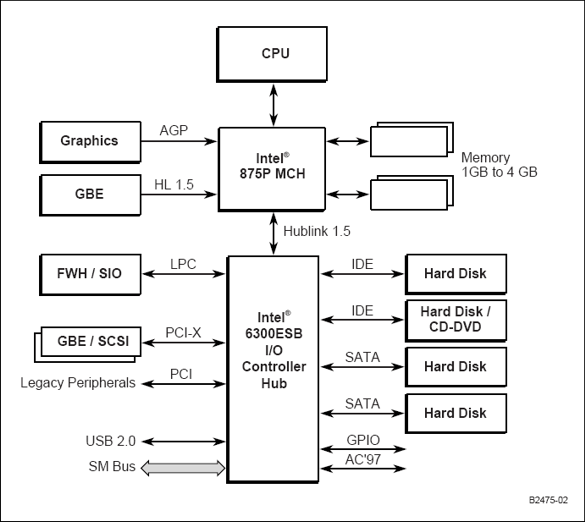AMD's Opteron 250 vs. Intel's Xeon 3.6 GHz in a Workstation Duel of the Elite
Platform Alternative I: Intel 875P + 6300ESB
The 6300 ESB is manufactured in 250 Nm and offers new features.
You don't necessarily need an enterprise chipset in order to run two Xeon processors, because since the introduction of HyperThreading, the Northbridge components have to be suitable for multi-threading operation. Consequently, desktop chipsets, such as the 875P (see above), are basically also good for Xeons. For the previous generation of Xeons, Intel had already developed for this purpose an "Enterprise Southbridge" by the name of 6300ESB (code name Hance Rapids), which restored the 875P to PCI-X-slots. Naturally, the connection to the 875-chipset achieves the usual 266 MB/s of the hub interface, so that fast PCI-X equipment running at over 66 MHz does not make any sense.
In comparison to the ICH5, the 6300ESB only offers four USB 2.0 ports, as well as a stripe size limited to 64 kB when using the integrated RAID 0.
Interestingly, the 875P chipset currently offers the best system performance for the Nocona Xeons (ca. 4.1 GB/s), as Dual-DDR400 is supported, whereas the E7525 supports a maximum of Dual-DDR333 or DDR2-400(3 GB/s). Also, the latter so far has proven to be faster in practice.
This graphic shows all interfaces of the 6300ESB Southbridge.
The well-known ICH5R-Southbridge lives on at Xeon.
Dual Nocona with the Canterwood Chipset on the DH800 from Iwill. This platform supports only AGP for the graphic interface and is combined with the 6300 PXH Southbridge.
Get Tom's Hardware's best news and in-depth reviews, straight to your inbox.
Current page: Platform Alternative I: Intel 875P + 6300ESB
Prev Page Not Downward Compatible, Continued Next Page Platform Alternative II: Intel E7505 + P64H2 + ICH4
Patrick Schmid was the editor-in-chief for Tom's Hardware from 2005 to 2006. He wrote numerous articles on a wide range of hardware topics, including storage, CPUs, and system builds.
-
bgd73 hey thanks for this. There is errors in the test, especially in memory speed of xeons, in fact, it is ridiculous. I am going for older 7525 chipset in CEB motherboard...these machines are just getting started. I be sure to go for HT. thanks.Reply



